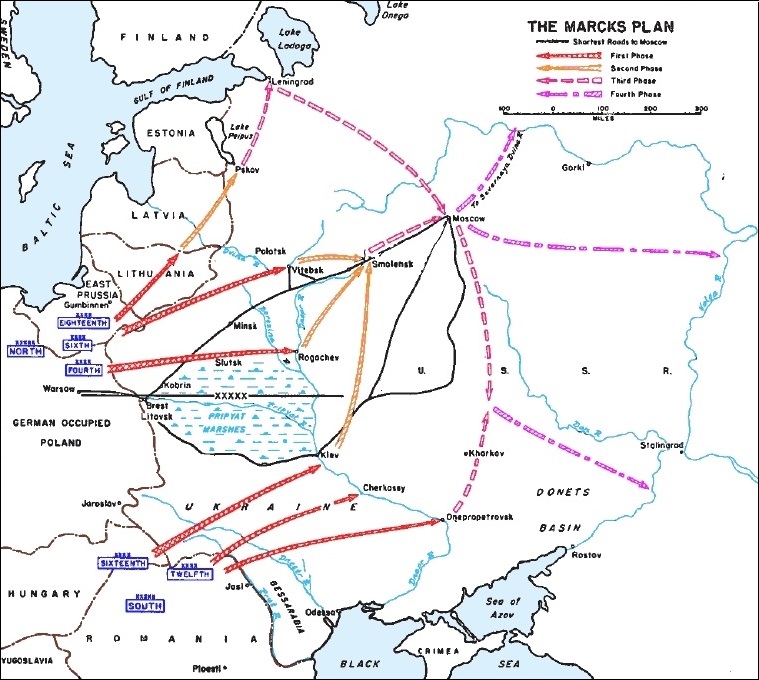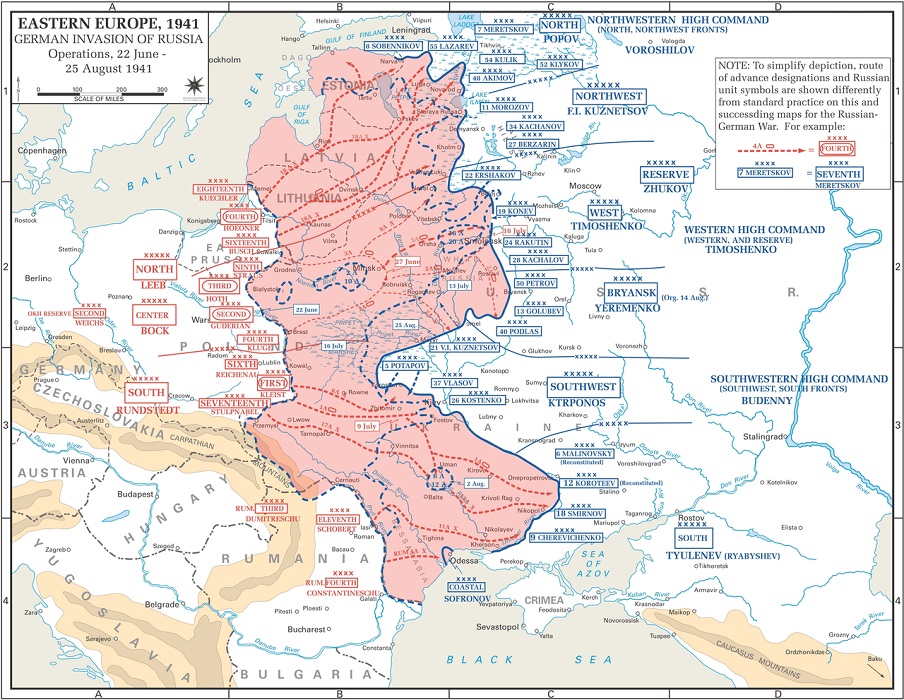● ● ●
It may
well be said that the turning point of the Second World War
was reached on the day that Nazi Germany invaded the USSR:
22 June 1941. At that moment the Grand Alliance (as
Churchill called it) of Britain, America and Russia became
possible, for it seemed only a matter of time before the
United States would enter the war as well. And by December
1941, when the USA did come in, the failure of Germany's
drive to the east was obvious to all. The USSR had not been
defeated in a single blitzkrieg campaign; indeed, it was the
German Army that was fighting for its survival. And the Grand Alliance having become a reality,
faced with its overwhelming power Germany could no longer
hope to win the war.
But
might things have turned out differently? Could Germany have
defeated the USSR in 1941? This question has been debated
since the war ended in 1945. Those who think that a German
victory was never possible offer powerful arguments.
They point out that Germany’s military advantages in 1941
constituted a wasting asset, bound to dwindle and disappear, while the USSR’s military
potential was enormous, particularly in
alliance with the UK and the USA. Those who think that a
German victory was possible tend to point the finger of
blame at Hitler, whose meddling, they assert, threw away
Germany’s one chance to knock out the USSR.
Whether
Nazi Germany could have defeated the USSR at all is
a doubtful question, whoever was commanding the former’s
armies. If we assume, however, that the Army High Command (Oberkommando
des Heeres or OKH)
had been given free reign to conduct Operation Barbarossa as
it saw fit, the 1941 campaign may well have been brought to
a successful conclusion with the capture of Moscow. This was
the objective of the preliminary invasion plan, code-named
Otto, known informally as the Marcks Plan after its
principal author, that was drawn up by the OKH in 1940. As
the map shows, it envisioned an operation in four phases,
defeating the Red Army in the western USSR, capturing
first Leningrad, then
Moscow, and
finally advancing to the
A-A
(Arkhangelsk–Astrakhan) line, bringing most of European
Russia under German occupation. Two army groups would carry
out the offensive, one north and one south of the Pripyat Marshes.
But Hitler was dissatisfied with the Marcks Plan and in his
Directive 21 for the invasion of the USSR he amended it to
provide three army groups, two of them making the main
effort north of the Pripyat Marches with Leningrad and
Moscow as simultaneous primary objectives. As a necessary
preliminary, the Red Army formations standing in the western
USSR would be encircled and destroyed before they could
withdraw to the east. The A-A line remained
the ultimate, albeit vaguely defined, objective. This
revised plan was given the code name
Barbarossa.

Operation Otto, the preliminary OKH plan
for the invasion of the USSR (Department of History, USMA
West Point)
Operation Barbarossa commenced on 22 June 1941, and the Red
Army forces in the western USSR were soon routed, suffering
astronomical losses in both men and material. But neither Leningrad nor Moscow were captured and by late
July OKH realized that it had seriously underestimated the
strength of the Red Army. For every division destroyed, a
new one appeared in the enemy’s order of battle. It was true
that many of these divisions were hastily organized and
poorly trained. Some were formed with personnel drawn from
the various branches of the NVKD; others consisted of
“workers’ militia” units. Many lacked artillery, antitank
guns—even mortars and machine guns. And Soviet troops
who'd been bypassed or encircled continued to resist tenaciously, posing a
worrisome threat to the Germans' vulnerable flanks and lines
of communication. It was clear that
the Red Army, if down, was not out.
As for the German armies, heavier-than-anticipated casualties
and
growing supply problems were beginning to make their effects
felt. The
all-important mobile forces especially—the panzer and motorized
infantry divisions—were in urgent need of rest and
refitting. An operational pause was clearly necessary so
that the armies could be resupplied and
reinforced before resuming the offensive. It was during this
lull that the strategic dispute between Hitler and the OKH
played itself out.
Brauchitsch, the Commander-in Chief of the Army, Halder,
the Chief of the OKH, Bock, commanding Army Group Center, and Guderian, commanding Second Panzer Group, believed that an attack on the Moscow
axis would compel the enemy to stand and fight, resulting
in a decisive battle that would destroy the main body of the Red
Army and end with the capture of the Soviet capital. But Hitler disagreed: He desired to
capture Leningrad, then switch the main
effort to the southern sector of the front. The Führer
believed that capturing the economic resources of
the Ukraine would irretrievably cripple the USSR, adding
that those resources were essential to the long-term
German war effort. He also insisted that it was necessary
both to eliminate the surrounded enemy forces behind the
German front line and to
destroy the still-formidable Red Army forces facing Army
Group South in the Ukraine. He was deaf to OKH’s argument that
victory on the Moscow axis would secure those objectives
in any case.
Needless
to say, the Führer's opinion prevailed: Army Group North was
instructed to resume its advance on Leningrad, and in late August
the main effort was switched from the central to the
southern sector of the front. Though the Leningrad offensive
soon stalled, the Germans scored a
resounding victory in the Ukraine. Hitherto the Red Army in that
region had put up a stout fight against Army Group
South, maintaining its cohesion despite losing ground. But the intervention of Guderian’s
Second Panzer
Group, descending upon the enemy's rear in the Kiev
area, caused the defense to collapse.

Operation Barbarossa: Initial German
deployments and first phase (Department of History, USMA
West Point)
The
First Battle of Kiev, which ended in the third week of
September cost the Red Army more than 600,000
casualties. But this German success, though impressive,
was not decisive. Thanks to the lateness of the season, for
the Germans there were no vital objectives within
reach east of Kiev. The Russians, however, could still trade space for
time, and with mobilization reaching full flood and
reinforcements coming in from the eastern USSR, they could
still replace their losses. The German main
effort was therefore switched back to the Moscow axis, the
drive on the capital resuming on 30 September—unsuccessfully, as
things turned out.
However,
had the advance to Moscow been resumed in late August, after
the German armies in that sector had been rested, reinforced
and resupplied, things could have turned out very
differently. At that date Red Army forces on the Moscow
front were still in shaky condition and a timely attack by
Army Group Center might well have smashed them. And in
that case what might have happened? First, it would probably have led
to the fall of both Moscow and Leningrad. The Soviet capital was the
nexus of rail and road communications in central and northern Russia. Its
capture by the Germans would have isolated the Leningrad
region, leading to a more or less automatic collapse of the
Red Army in that sector. Second, the fall of Moscow and a
further eastward advance by the Germans toward Gorki would
have menaced the northern flank of Soviet forces in the Ukraine, compelling them to retreat eastward, possibly as far as the
Volga.
Still,
in strictly military terms even so gigantic German victory
would not necessarily have finished off the USSR. But as
Clausewitz noted, war is the continuation of politics by
other means, so the political consequences of Moscow’s fall
must also be considered.
In that
connection it should be noted that Stalin himself harbored
grave doubts about the USSR’s staying power in a war against
Germany. He realized better than anyone that such spectacles
as the Five-Year Plan and military parades in Red Square
concealed potentially fatal fragilities. The deprivations of
the 1930s—crash industrialization, the collectivization of
agriculture, the Great Purge—had levied a hideous toll of
death and suffering on the Soviet peoples. Stalin knew that he and his regime were widely hated; he had
good reason to fear that in the event of a German invasion,
the people might turn on the Party. Moreover, he knew that
thanks to his purge of its officer corps, the Red Army was
quite unprepared for war. Stalin believed that at all
costs, war with Germany, however inevitable in the long
term, had to be delayed for as long as possible. That was why the Soviet leader
took such pains to maintain good relations with Germany
between 1939 and 1941, and why he was deaf to credible
intelligence concerning Hitler’s real intentions.
So if
Moscow had fallen in the summer of 1941, the political
fallout might have secured victory for Germany. After presiding
over such a catastrophic defeat, it's plausible to think
that the Soviet regime would have collapsed, perhaps with a
cabal of generals putting Stalin and his cronies in front of
a firing squad. Or if Stalin managed to weather the debacle
he might have thrown up the sponge, accepting harsh peace
terms as the price of survival, with the option of renewing
the fight another day. Who can say? Certainly a case can be
made for the German capture of Moscow in late August-early
September of 1941—but that, had it
happened, would have cleared the way for a near-infinity of
alternate histories.
● ● ●